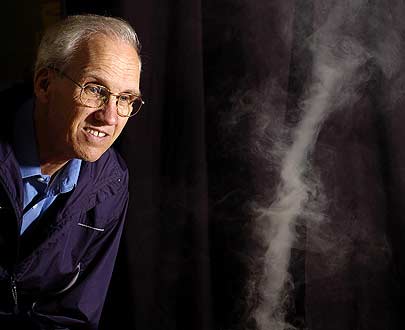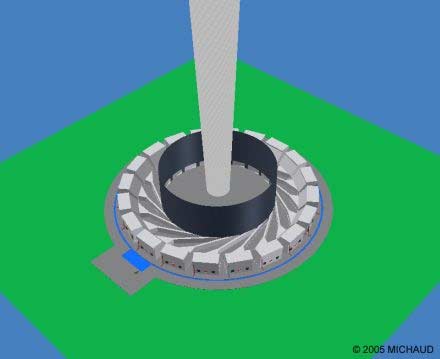A curious-looking wood cylinder with a round opening at the top and a small heating element at the bottom sits in Louis Michaud's garage, bicycles hanging overhead and a workbench pressed against the wall.
The retired refinery engineer picks up a propane torch, lowers it into the opening, and lights a tiny piece of saltpetre. A loud fizzling is heard and a thick smoke begins to rise from the centre.
At first the smoke has no form, but it soon swirls upward into a well-defined vortex – what, on a larger scale, you might call a tornado.
"The air is being drawn in on its own. There's no fan or anything involved," says Michaud, explaining the physics of convection and how rising air behaves like a spinning top. "This is what's going on in the atmosphere. The air is heated in the bottom by the sun and then it rises, cools and comes back down again."
It may seem like a hobby – a home science experiment meant to occupy time during retirement – but this 66-year-old isn't just tinkering.
Michaud has spent the past 40 years studying tornados and hurricanes, and is convinced it's possible to engineer and control powerful, full-scale whirlwinds and harness their energy to produce emission-free electricity.
Forget wind farms and their intermittent operation: the future of electricity generation could be tornado power on demand.
Michaud has adapted this process to create what he calls a vortex engine, and has patented the invention in both Canada and the United States. Recently, he formed a company called AVEtec Energy Corp. with an aim to turning this unconventional – and to many, unthinkable – approach to electricity generation into a commercial reality.
His challenge now is to persuade venture capitalists, energy executives and at least one community to back the construction of a full-scale vortex engine, capable of producing a power-packed funnel cloud that stretches kilometres into the atmosphere and runs on waste heat, ideally from a power plant.
"I'm talking about a 200-megawatt device, which would be 200 metres in diameter," says Michaud. That's enough electricity for 200,000 homes.
"The vortex would be one to 20 kilometres high, and have 10 turbines (at the bottom) each producing 20 megawatts."
It's a scary thought, and a great basis for a movie script, bringing together the don't-mess-with-nature themes of the films Twister and Jurassic Park. One can imagine the back of this DVD case: "A monster man-made tornado loses control and jumps out of its pen, terrorizing a community and ripping a path through dozens of harmless wind and solar farms. Rated R."
Michaud concedes that ideas related to weather modification and "cloud seeding" are typically shunned by the scientific community and feared by the public.
"People say it's impossible initially. And then they say, well, if you can do it, it's too scary – how are you going to control it?" he says. "But once you demonstrate you can operate it safely in a remote location, then you might be willing to have one located in a city."
He's critical of the vast majority of climatologists who focus exclusively on weather prediction, arguing that it's a waste of their skills and research efforts. "I tend to think that prediction is not the way of understanding things."
It's not likely we'll be seeing tornado generating stations operating in Toronto anytime soon, but Michaud's vortex engine is drawing attention, and has already attracted some research funding from the Ontario Centres of Excellence.
The University of Western Ontario's wind-tunnel laboratory, through a seed investment from OCE's Centre for Energy, is studying the dynamics of a one-metre version of Michaud's vortex engine – like the one in his garage. The lab is also conducting computer simulations to look at the impact of cross winds on a 20-metre model.
"When the idea was first brought forward we were like, `tethered tornados,' hmmm ... But we looked at the patent and thought it merited further study," says Nicole Geneau, manager of business development at OCE's Centre for Energy.
"We have a strong history of picking things up that seem like crazy ideas, and at least giving them a shot. We should not stand in the way because of preconceived bias."
Rick Whittaker, vice-president of investments at Sustainable Development Technology Canada, which funds clean-technology demonstration projects, also keeps an open mind.
"They're not violating the laws of physics. The question isn't whether this strange idea will work or not, it's a matter of the degree to which it would be more economically attractive than the alternative.
"That's the type of idea we actually seek out."
The next step is to build and study the performance of a four-metre model, requiring a further injection of OCE funds of about $300,000. The plan would be to scale up from there, moving on to 10-metre, 20-metre, and 50-metre pilot plants, likely requiring millions of dollars in both public and private funding.
On a commercial scale, the plant would require a heat host, such as a power plant, that could provide the vortex engine with a constant supply of hot water "fuel."
Here's how it works: Waste heat, a byproduct of any fossil fuel or nuclear plant operation that is typically vented into the air through cooling towers, is carried by water pipe to a vortex engine facility nearby. The hot water enters a number of cooling cells stationed around the facility where fans push dry air across hot pipes.
The air picks up the heat and enters the vortex through 10 or more angled ducts, causing the air to swirl inside. The heated air begins to rise in a spinning motion, gathering energy the higher it gets and creating a vortex. As the vortex gathers momentum it begins to suck air through the cooling cells, at which point the fans that initially pushed in the air now function as turbines that generate electricity.
As long as the heat is available, the vortex will keep spinning.
Michaud figures that a commercial plant of between 200 metres and 400 metres in diameter could generate 200 megawatts of baseload power and be built for $60 million. But $20 million of that, he points out, would be offset because the power plant would no longer need a separate cooling tower.
Compared to nuclear, even coal, it's a bargain. Michaud estimates that one of his vortex engines would cost less than one quarter the cost of a coal plant, and that's excluding the cooling tower benefits and the fact that no ongoing fuel expenses are needed to keep it going.
Nilton Renno, a professor at the department of atmospheric, ocean and spaces sciences at the University of Michigan, has spent his career studying tornados and water spouts. He says there's no reason why Michaud's vortex engine wouldn't work.
"The concept is solid," says Renno.
Top atmospheric scientists from the University of Oxford, the University of Cambridge and the Massachusetts Institute of Technology have joined AVEtec's advisory board. The group includes respected MIT meteorology professor Kerry Emanuel, perhaps best known for establishing a strong link between hurricane intensity and global warming.
Still, Renno isn't without reservations. He's particularly concerned about the ability to control such a powerful monster.
"The amount of energy involved is huge. Once it gets going, it may be too hard to stop," he says.
Michaud argues that the power of the vortex engine could be turned down, or shut off completely, by limiting the amount of air flow into the base of the funnel. He also dismisses any idea that his vortex engine would be loud and menacing, pointing out that tornados make noise and become more destructive as they draw debris into their funnels.
The vortex engine, by contrast, would be kept stationary in its arena and only draw in debris-free air, making it far less visible than a typical tornado.
Renno isn't convinced. He points out that as the vortex grows it would likely be able to pull in warm ambient air from many kilometres away, creating the possibility for debris accumulation and making it more difficult to manage.
Asked whether he'd accept a vortex engine in his own community, Renno replied: "No, not close to my house" – at least not until the concept is proven.
Whittaker of Sustainable Development Technology Canada says public demonstrations will be key to gaining acceptance. "Perceptions are created because of lack of information."
Michaud realizes he will need to break down a lot of mental barriers before pushing his idea beyond the stage of intellectual curiosity. He doesn't rule out starting small, possibly promoting the creation of less powerful vortex engines as tourist attractions that the public can visit, see and learn about.
"I was thinking if we got one of these to produce a tornado 200 metres high, the first people to buy one would be Disneyland."
If people accept it, the potential is unlimited. He says down the road, hundreds of vortex engines could be located in the ocean along the equator, where the warm tropical water would provide an endless source of energy.
Why would anyone do such a thing?
To cool the planet, Michaud says. Greenhouse gases in the atmosphere are what prevent the sun's heat from radiating back into space, he explains. A series of controlled tornados along the equator would carry that heat to the outer edges of the atmosphere, where it could more easily escape.
In other words, Michaud believes man-made tornados could function as exhaust systems for the planet, a massive air conditioner that could help manage global warming.
There's simply too much at stake to ignore this potential, he says.
"I could work as a consultant and get more money for the effort, but this is something I like doing. If you realize there's a potential there and nobody is doing anything about it, I don't think it would be right for me to say, okay, nobody is listening – too bad."
Whatever the outcome, Michaud's four grandchildren, aged 4 to 8, are loyal backers of his work. Whenever they visit, the first words out of their mouths, says Michaud, are: "Grandpa, can you show us the vortex again?"
And his wife? "She's been quite patient."

